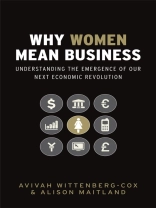WOMEN MEAN BUSINESS
‘…gives example after example of the price that we all pay for a situation in which ‘women may hold the keys but men still control the locks’.’
The Times
‘What’s especially valuable is the authors’ analysis of where companies go wrong in managing women…that’s how it will help women in the workplace.’
Harvard Business Review
‘Lays out the importance of retaining women in senior leadership positions.’
Harpers Bazaar
‘Wittenberg-Cox and Maitland have opened new ground.’
Management Today
WOMEN MEAN BUSINESS
They make up much of the market and most of the talent pool. Reaching women consumers and developing female talent is essential for sustainable economic growth in the 21st century. Studies show that better gender balance in business means better bottom line results and greater resistance to economic crises.
So why are there still so few women in leadership roles in business? Why are companies struggling to respond to today’s female consumer? Why is there a persistent pay gap between men and women around the world?
Why Women Mean Business takes the economic arguments for change to the heart of the corporate world. Fully updated in paperback, the book shows why getting gender right matters – as much when the economy’s bust as when it’s booming. A must-read, packed with ideas from companies that have made it work, views from top business leaders and step-by-step guides to how we can all become gender bilingual.
สารบัญ
Foreword by Niall Fitz Gerald KBE xiii
Preface by Michael Kimmel xv
Acknowledgements xxi
CHAPTER ONE: WOMENOMICS 1
Guarantors of growth 1
The strategic side of the gender divide 6
Opportunity cost 9
Valuing difference 12
Becoming ‘gender-bilingual’ 15
Declining demographics is not destiny 18
21st century forces: weather, women, web 22
CHAPTER TWO: MOST OF THE TALENT 27
The ‘talent wars’ are here 28
Female brainpower 30
Under-used talent 34
The role of business schools 36
Tapping into the pool 39
Recruiting: making women welcome 40
Retaining: structural repairs needed 44
Promoting: return on investment 57
Building better boards 62
Legislating solutions – the controversial quota 65
CHAPTER THREE: MUCH OF THE MARKET 73
Purchasing power – beyond parity 75
Female finances 77
Sex and segmentation 85
The many faces of marketing to women 89
Shut-your-eyes 90
Marginalise 93
Specialise 94
Prioritise 96
CHAPTER FOUR: BECOMING ‘BILINGUAL’, WHATCOMPANIES CAN DO 103
A fresh look at traditional approaches to gender 103
Equal and different 107
Diversity dilemmas 110
Recognise that ‘best’ is biased 113
Surprising sectors 119
A new approach to gender 120
Understand the starting point 120
Personalise the conversation 124
Manage the metaphors – the power of vocabulary and vision126
The building blocks of bilingualism 130
1 ‘Getting it’: top management commitment 131
2 Management bilingualism: proactively managing difference132
3 Empowering women: the knowledge and networks to succeed133
4 Banning bias: identifying and eliminating systemic bias fromcorporate systems and processes 134
CHAPTER FIVE: SEVEN STEPS TO SUCCESSFUL IMPLEMENTATION141
Key success factors 141
1 Awaken your leadership team 143
2 Define the business case 148
3 Let people express resistance 151
4 Make it a business issue, not a women’s issue 155
5 Make changes before making noise 162
6 Don’t mix up the messages 166
7 Give it a budget, not just volunteers 170
CHAPTER SIX: CULTURE COUNTS, WHAT COUNTRIES CAN DO183
Making bosses and babies 183
Best and worst: surprising results 187
Imperfect deal in America 199
Continents of contrast 206
Public policy pull, private sector push 212
CHAPTER SEVEN: FIGURING OUT FEMALES 223
What companies need to know about women 223
Discomfort with ‘politics’ 225
The conversations that matter 236
Careers are not straight lines 238
Phase 1: ambition 242
Phase 2: culture shock 244
Phase 3: self-affirmation 252
The lure of entrepreneurship 256
Alternative views of ‘power’ 258
Sex, success and the media 259
Change agents on their own terms 264
CHAPTER EIGHT: TOMORROW’S TALENT TRENDS . . . TODAY, ‘WOMEN-FRIENDLY’ MEANS’PEOPLE-FRIENDLY’ 271
New models of work 273
Fathers count too 277
Technology as enabler 280
The value of ‘grey’ brainpower 285
Making the most of the ‘Me’ generation 291
The future is already here 296
CHAPTER NINE: CONCLUSION, FROM BETTER BUSINESS TO A BETTERWORLD? 301
New voices, new choices 302
New measures of success 306
A challenge for business 309
Index 317
เกี่ยวกับผู้แต่ง
AVIVAH WITTENBERG-COX is CEO of 20-First, one of
Europe’s leading gender consultancies. 20-First works with
progressive companies interested in building gender
‘bilingual’ organisations that capture the
opportunities offered by the other half of the talent pool and the
other half of the market – the female half. The firm’s
renowned Bilingual Leadership programmes help executives –
men and women – manage difference more effectively.
Avivah is also the Founder and Honorary President of the
European Professional Women’s Network (href=’http://www.europeanpwn.net/’>www.European PWN.net), a
certified executive coach and was a Visiting Coach at INSEAD. She
is a popular speaker on leadership and gender issues across Europe
and has had articles and interviews published in publications such
as the International Herald Tribune and the Financial
Times. Canadian, French and Swiss. In 2007, ELLE Magazine
recognised her as one of the TOP 40 Women Leading Change. She lives
in France with her husband and gender balanced children (a son and
a daughter).
ALISON MAITLAND is an independent journalist and
commentator who has been researching and writing about women in
business for a decade. She spent 20 years with the Financial
Times, including eight years as Management Writer. Her other
specialist areas are leadership and corporate responsibility.
Alison is a Senior Visiting Fellow in the Faculty of Management
at Cass Business School, City University, London. She is a
conference speaker and moderator and she directs the Work-Life
& Diversity Council of The Conference Board Europe. She served
on the advisory group for the Equal Opportunities
Commission’s 2007 investigation into the Transformation of
Work. She lives in the UK with her husband and two daughters.












